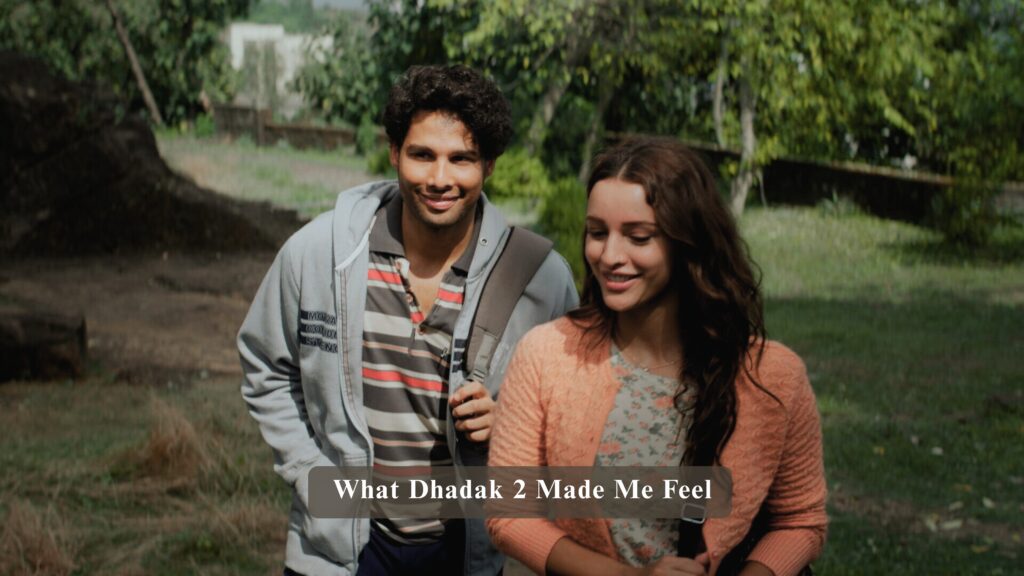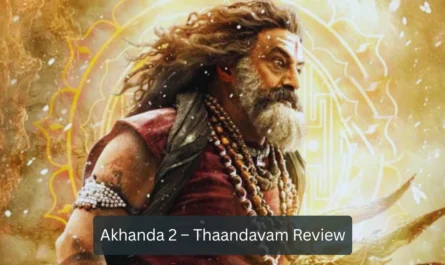Introduction – When a Movie Doesn’t Let You Go
Some movies leave you smiling when the credits roll. Others leave you thinking. And then, there are a few that leave a weight in your chest—where even the silence after the screen goes dark feels louder than the dialogues. That was my experience with Dhadak 2.
Caste and Love in Indian Cinema I went in expecting another tragic romance—something typical. But what I saw wasn’t just a love story. It was a social commentary, layered and piercing. Dhadak 2 didn’t entertain me—it made me uncomfortable in the best way possible. It reminded me how powerful cinema becomes when it dares to be honest—especially when it explores something as complex as caste and love in Indian cinema.
Two People, Two Worlds
The film starts with Neelesh, played by Siddhant Chaturvedi. He’s a law student from a marginalized caste background, carrying both ambition and trauma. You can sense that this is someone who has always been told “no”—not directly, but in a thousand subtle ways. His eyes carry history.
Then comes Vidhi, portrayed by Triptii Dimri. She’s from a well-off upper-caste family, protected by wealth and tradition. But unlike many of her peers, she isn’t content inside her bubble. Something in her wants to question the rules.
Their first few scenes together are almost innocent—accidental smiles, small exchanges, curiosity. But if you’ve lived in India, you know where this is heading. You know love like this comes at a price. That’s what makes Dhadak 2 hit so hard—it doesn’t pretend caste is a backdrop. It’s the wall between their hearts.
Siddhant Chaturvedi’s Silence Is Louder Than Any Line
There’s something haunting about Siddhant’s performance. He doesn’t shout. He doesn’t give grand speeches. But every expression speaks volumes.
There’s a moment in the film where Neelesh is asked to “talk about his identity” in a college event. He pauses. Just a pause. And that pause felt more real than any line of dialogue. Because if you’ve ever been asked to explain who you are—especially when you come from a space society keeps invisible—that hesitation carries more pain than any monologue could.
This performance isn’t about drama. It’s about restraint. About what you hold back. And in the context of caste and love in Indian cinema, that’s incredibly rare.
Triptii Dimri’s Boldest Role Yet
I’ve seen Triptii Dimri in other films, but here, she truly transforms. Vidhi is not your typical rebellious rich girl. She doesn’t start as someone trying to break rules. She grows into that. And that arc is written and acted with grace.
She begins sheltered, repeating what she’s been taught. But love forces her to see the cruelty her family normalizes. There’s a powerful moment when she questions her father’s silence. No screaming. Just a line that lands like a slap:
“You never taught me to ask why we’re always right.”
It’s moments like these that show the power of Dhadak 2—where emotional impact doesn’t come from theatrics, but from truth.
The Real Villain Isn’t a Person
A brilliant move in the film? There’s no big villain. No cartoonishly evil parent. No loud opposition. The enemy here is systemic—slow, invisible, and everywhere.
It’s in the way Neelesh’s classmates joke about “merit.”
It’s in the landlord’s sudden change of tone.
It’s in the silence of bystanders.
Dhadak 2 doesn’t need to create drama. It just shows the everyday truth. The subtle violence. The institutional cruelty. The caste hierarchy isn’t shouted—it’s breathed into every scene. And that’s what makes it so devastating.
In the history of caste and love in Indian cinema, we’ve seen the topic either ignored or exaggerated. But here, the balance is razor-sharp.

Sound, Silence, and the Visuals That Speak Volumes
The film is unusually quiet. Not in a boring way, but in a way that makes every word matter more.
There’s a scene after the lovers run away. They’re sitting on a rickety bus, holding hands. No music. Just engine noise and blinking streetlights. I didn’t realize I was holding my breath until the scene ended. That’s the level of emotional precision here.
Even visually, the film doesn’t glamorize. The cities are dusty. The homes are cramped. You feel the heat, the tension, the claustrophobia. It’s real. It’s uncomfortable. It’s how stories about caste and love in Indian cinema should look—not stylized, but scarred.
Why Dhadak 2 Isn’t Just a Sequel
Let’s talk about the first Dhadak.
Beautiful songs. Great cinematography. But let’s be honest—it skimmed the surface. It hinted at caste, but didn’t commit to the conversation. It was a love story with caste as decoration.
Dhadak 2 does the opposite. It dives in. It forces you to see what happens when love crosses boundaries that society still defends with violence.
The first movie was about romance.
The second is about resistance.
And that shift matters. It shows how the conversation around caste and love in Indian cinema is growing up—and getting braver.
Inspired by the Lives We Ignore
Though fictional, this story feels like it was lifted from reality. And in many ways, it was. The news is full of real-life Neeleshes and Vidhis. Young couples punished for loving across caste. Families torn apart. Children disowned. Honour killings still exist.
Dhadak 2 gives these stories a face. It doesn’t pretend to solve anything. It just demands that we stop looking away.
And maybe that’s what makes it feel so personal.
Final Thoughts – Why I’ll Remember This One
There’s one final scene I can’t forget. Neelesh sits in a room he can no longer call home. On the wall is a degree he fought for. But now it means nothing. The system has already decided what he deserves.
He doesn’t cry. He doesn’t break down. He just stares. Still. Defeated. But breathing.
And maybe that’s the most tragic part. He’s still breathing. Still here. But broken.
I walked out of Dhadak 2 knowing this wasn’t just a movie—it was a reminder. A challenge. A mirror.
Because when we talk about caste and love in Indian cinema, we’re not just discussing plotlines. We’re talking about people’s lives. Their right to feel. Their right to belong.
This film doesn’t let you escape that truth. It holds your gaze. And maybe that’s what makes it unforgettable.
Hungry for more film-related content? Discover more movie blogs here





One thought on “Caste and Love in Indian Cinema: What Dhadak 2 Made Me Feel”